Facts and Queries
The FAQ covers Mobile Planetarium for schools, Fixed Planetarium, Planetarium Shows, Planetarium Education and lot more.
A. GENERAL
-
What is a Planetarium?
- A Planetarium primarily simulates the sky above our head.
- It is a model of the sky.
- The content in a planetarium is always projected on a dome (which can be fixed or mobile) and not on a flat screen as the sky above our head is also like a huge dome (half of the celestial sphere
- A planetarium is the most effective teaching aid for astronomy for school and college students.
- The prime purpose of a planetarium is to teach astronomy.
- It can be digital or analog.
- It can be fixed or mobile.
- It is also a novel way of playing non astronomy content in a 3D immersive environment (in case it is a digital planetarium and not an analog planetarium).
- It is also used to create awareness about science and technology and human space endeavour from the perspective of common man thus is often promoted as a sky or space theatre.
- A digital planetarium by virtue of the technology is also used to play non astronomy content ranging from Earth Science to Biology to almost any other topic in a novel and stimulating way.
- A planetarium by playing relevant content is also used as a tool to inculcate scientific temper.
- There is a general misconception that a planetarium is meant to show only Planets/ Solar System
- A planetarium is not a research and development lab.
Note: -
What is the difference between a Digital and an Analog Planetarium?
Analog Planetarium Digital Planetarium One can say that it is like a typewriter. It is a computer like DigiskyTM. Can only show the classical sky i.e. the sky that we see with naked eyes (about 3000 stars at a time). Can show the universe that is full of galaxies, stars, nebula, star clusters and a lot more. Not possible in analog technology. Can show the universe in visible as well as invisible light (various parts of the spectrum). Demonstrates only diurnal motion i.e. rise and set of celestial objects due to rotation of the Earth. Shows full suite of celestial motions i.e. Diurnal, Annual, Precessional, Retrograde, and Proper Motion of Stars. Not possible in analog technology. Can show all astronomy events like Eclipses, Transits, Occultations, Conjunctions, Planetary Alignments and Meteors. Not possible in analog technology. Can create skies from any location/ city (lat/ lon) on the Earth, from various other celestial bodies and from space from present, past and future. Not possible in analog technology. Can show telescopic view of celestial objects and a whole lot more... Not possible in analog technology. A digital planetarium by virtue of the technology is also used to play non astronomy content ranging from Earth Science to Biology to almost any other topic in a novel and stimulating way. Creates immersive environment. Creates 3D immersive environment. -
What are the main parts of a Digital Planetarium?
- Digital projector(s) with suitable optics that can project on a full dome.
- Computer(s) that can render or play the full dome content/ scenarios through various software.
- Real time render full dome planetarium sky simulation software with extensive data base of celestial bodies.
- Pre-recorded shows.
- Content Library.
- Audio system.
- User Interface to control the server and manipulate the content.
- And a dome (which can be fixed OR mobile/ portable/ packable) as a screen to project the simulation software/ shows/ library.
-
What is the prime difference between a Fixed Planetarium and a Mobile Planetarium?
Mobile Planetarium Fixed Planetarium Has an inflatable portable (mobile) dome like Digidome™ Primarily has a fixed dome. No Tedious field trip is required. Tedious field trip is required One can choose the venue and thus the homogeneity of audience. Usually it is a public planetarium unless it is located in a School/ University. Plays highly customized content/ shows through digital technology to cater specific needs of the audience. Plays general shows. -
Who should buy a planetarium?Schools, Colleges, Universities, Science Centres, Science Museums, Science NGOs, Camp Organisers, Townships, Malls, Fun Parks.
-
Are you a Manufacturer/ Planetarium System Integrator?Yes, Digisky™ and Digidome™ Leo Planetaria™, Planetarium EducationTM are our registered trademarks.
-
Do you provide Mobile Planetarium on Rental/ Hire basis also?Yes, we do. Check our Rental Info page.
-
Can you export to our country?At present we export to Middle East Countries. Send your details like country, city, company name for the export feasibility.
-
Can you provide us with a vendor neutral utility and feasibility report on Mobile Planetarium and/ or Fixed Planetarium?Yes, contact us at intouch@leoplanetaria.com or call Mr. Vikas Nautiyal at 09811275851
-
Can we become your representative/ distributor/ dealer/ franchises for sale/ Rental?Yes, you can call at +91 9811275851 for the feasibility.
-
What do you mean by Planetarium Education™?
Or
What the Utility of a Planetarium for a School/ College/ University? -
How frequently can I use the In-House Planetarium for my School students?At least ones in every year quarter in a year to each and every student of your school (K-12).
-
We would like to see a Demo.
- The Demo is feature based and is for one hour.
- The demo can be arranged at our Delhi office. Just inform us 3 days advance. Our office is 30 minutes drive from airport.
- In case we have an outreach programme/ exhibition/ workshop at a place near your location then you can visit us there, this may take time.
- In case you want us to come over to your place (anywhere in India/ Middle East Countries/ Nepal) inform us in 10 days advance and the travel cost for two resource persons and the planetarium system has to be borne by you.
- Contact: Mr. Vikas Nautiyal 09811275851 for Demo.
B. Planetarium Projection Systems (Technologies)
-
What Planetarium Technologies are available in the market?A planetarium projection system technology wise can be:
- Opto-mechanical/ Star-ball (analog)
- Digital
- Mix of Opto-Mechanical and Digital i.e. Hybrid.
Digital technology/ systems are far more superior than Opto-mechanical systems (analog) as there is not much of a choice in the latter when it comes to content development thus limiting the pedagogical/ content options. Superiority of digital technology is simply unquestionable. However, a Star-ball projection system still has unique advantage over digital projection system as it can show more realistic star fields i.e. jet black sky with stars as dots or points. The same can be achieved in digital technology to quite an extent by using high end digital projectors based on Digital Light Processing (DLP) or Laser technology that have high contrast ratio (non iris based) and resolution. If decision makers want the benefit of digital technology and are also keen on star fields then they can opt for a hybrid system. Of course this will substantially add up to the project, maintenance, training and running costs.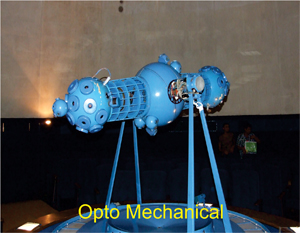
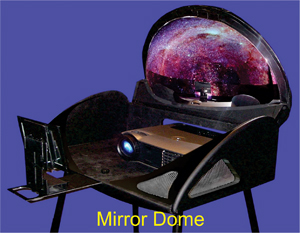 It is also important to understand that the two different projection systems in so called HYBRID planetariums by their intrinsic nature are mutually exclusive. Playing them simultaneously will not only create scenarios that are against astronomy for example stars in front of planets but also the brightness of digital projector(s) will affect the contrast and star fields of star-ball projector in an adverse way thus defeating its very purpose.
It is also important to understand that the two different projection systems in so called HYBRID planetariums by their intrinsic nature are mutually exclusive. Playing them simultaneously will not only create scenarios that are against astronomy for example stars in front of planets but also the brightness of digital projector(s) will affect the contrast and star fields of star-ball projector in an adverse way thus defeating its very purpose.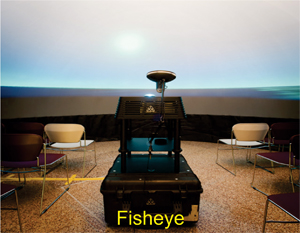 When it comes to digital projection systems there are three choices optics wise -
When it comes to digital projection systems there are three choices optics wise -- Spherical Mirror/ Mirror Dome System (placed on the circumference/ cove of the dome).
- Multiple Projectors System (placed on the circumference/ cove of the dome).
- Fisheye Projector System (placed on the centre of the dome).
Spherical Mirror (mirror dome) system is the cheapest among the above three but has following shortcomings in comparison to the other two.- Mirror Dome cannot create full sky/ dome and suffers from truncation (part of the sky is missing) thus defeating the very objective of a planetarium. In fact these systems are suitable for unidirectional viewing.
- Projection quality is not as good because of the intrinsic limitations of the mirror optics.
- Non availability of compatible and up to the mark real time render planetarium sky simulation software (PSSS) for mirror domes thus again defeating the very purpose of a planetarium. Note:
- Quite recently planetarium industry has introduced 3D planetarium systems where audience wears 3d glasses in the planetarium. However, their utility is highly debatable at this point of time not only due to the fact that they are too costly and there is hardly any 3D planetarium content that is available but a digital planetarium by virtue of full dome projection is already a 3D immersive environment.
-
What do you mean by Fisheye Planetarium Projection System a paradigm shift in Planetarium Projection Technology?A multiple projectors system to create full dome/ sky in a planetarium is primarily used to achieve higher brightness levels across the dome by adding up the individual brightness capacity of the projectors. Since now single digital projectors with small foot print (compact), very high brightness, contrast and resolution are available, one can achieve full dome/ sky projection with single projector mated with a suitable high quality fisheye lens especially for domes up to 12 meter diameter (about 120 reclining chairs) and there is no need to align, blend, maintain and upgrade multiple projectors. In recent years due to fisheye optics, free ware technologies usage and modular designs the scenario has changed drastically in favour of the user/ audience especially educational institutes as the planetariums have become cost effective and easy to operate, maintain and upgrade. In fact digitalization of mobile planetarium became possible only due to fisheye optics technology. Single Projector (Fisheye optics) system with DLP with modular design and a user friendly console which can be even tablet based actually liberates a planetarium from the obstructions and bulkiness associated with multiple projection system. The planetarium educator is free from operations hassles and can now focus on his prime responsibility i.e. the content and audience. Among the fisheye systems Laser technology has even better quality output than DLP however, laser projection is not only quite costly to buy and maintain especially in a developing nation but also suffers from large foot print and the projector may have to be placed quite high from the ground thus obstructing the full dome/ sky view. At present the laser fisheye planetarium projection systems are not prevalent, the world over. Majority of the planetariums that are being set up now days the world over especially for dome diameters up to 12 meters have single fisheye projection system. Due to the paradigm shift, Planetarium EducationTM is no longer a prerogative of the developed nations. In fact the decision makers can now implement Planetarium EducationTM at grass root levels in a cost effective way and can even scale it up to the desired demographical and pedagogical levels.Among the various digital projection technologies like LCOS, LED, DLP, LASER, etc DLP is most prevalent and tested in planetarium industry the world over as:-
- LCD though cheaper suffers from screen door effect (i.e. fine lines separating the projector's pixels become visible in the projected image) which is not suitable for planetarium use.
- LED projectors though cheaper and even have longer lamp life up to 20,000 hours (thus low maintenance cost) does not have high brightness/ lumens (at this point of time), thus not suitable for planetariums having more than 7 meter diameter
- LCOS though have high contrast ratios like DLP but again like LED has low brightness/ lumens.
- LASER has no shortcoming as such for planetarium purpose except for the fact that there prices are astronomical, they are bulky and their maintenance and running cost is too high. Remember :
- The quality of a digital projector is measured primarily in terms of its resolution and contrast ratio.
- Higher the contrast ratio and resolution better it is for the planetarium projection.
- Bigger the dome brighter has to be the digital projector. Brightness of a digital projector is measured in lumens.
- A higher resolution and a higher contrast ratio would mean better projection quality primarily in terms of darker skies and point/ dot stars.
- For higher and higher resolutions the improvement in projection quality becomes quite subjective to the human eye.
- The DLP technology has intrinsically better contrast thus darker skies.
- The lamp/ bulb of a digital projectors is a consumable part as it evolves with time and becomes dimmer and dimmer and is to be eventually replaced.
- It is the native resolution of a projector that matters. Higher non native resolutions are of no use.
- Beware of the projector advertising 1: 50,000 or more contrast ratio as it is based on automatic Iris which is useless in planetarium projection as while projecting stars the contrast falls down to 2000:1 or even less. Note:
- Quite recently Laser, DLP and LED Hybrid projectors with small foot print (compact) and quite high lamp life have been successfully tested in the mobile planetarium industry.
-
Could you further explain the difference between a Full Dome Planetarium and Mirror Dome (spherical mirror) Planetarium (sic)?
Full Dome Digital / Digisky™ Planetarium Mirror Dome Digital Planetarium (sic) Creates full sky, no part of the sky is truncated/ missing i.e. N/S/E/W directions and the entire sky above the horizon thus making it the most effective model of the sky or teaching aid for astronomy. Both the planetariums i.e. full dome and mirror dome use a hemispherical surface (dome) for projecting their content. However, part of the sky is truncated/ missing in a mirror dome planetarium (sic) thus defeating the very purpose of a planetarium as an effective teaching aid of astronomy. In other words Full Dome means Full Sky. In other words Mirror Dome means truncated sky. Following Motions and Grids that are prerequisite/ fundamental to understand or teach astronomy are demonstrated in the best possible way on a full dome through up to the mark sky simulation software. Diurnal, Annual, Retrograde, Precessional, Proper Motion of Stars, Ecliptic, Meridian, Celestial Equator, Circumpolar Stars, Ttropic Lines, Alt/ Az Grid, Universal Grid, Galactic Grid, and Analemma. Since the sky is truncated and moreover no up to the mark sky simulation software is available for mirror dome, the prerequisite/ fundamental to understand astronomy cannot be demonstrated in the best possible way. A full dome planetarium simplifies the complexity of the positional astronomy and various motions thus enabling students to grasp even complex astronomical concepts at an early stage and that too from altogether a different perspective. Not possible in mirror dome. Primarily plays astronomy content that is exclusive/ applicable/ relevant to the model of the sky/ full dome and which otherwise is of almost no use when played on a flat screen. Primarily plays content that is for flat screen but is novel when played on a truncated dome i.e. unidirectional It creates full immersive environment. It creates partial immersive environment that obviously is unidirectional. Truly liberates the teaching fraternity from the practical and intrinsic limitations of star gazing. It is meant for Planetarium Education™. Truly speaking it is not a planetarium and primarily plays non astronomy content on novelty basis. It is not meant for Planetarium Education™.
C. Real Time Render Planetarium Sky Simulation Software (PSSS)
-
What is Planetarium Real Time Render Sky Simulation Software?It is the soul of a planetarium. Primarily speaking it has an extensive and accurate data base of heavenly bodies like stars, deep sky objects like galaxies, nebula, etc, solar systems objects, like planets, moons etc. It creates full dome scenarios of the sky from the Earth, Space and various other Celestial Bodies at different times.In addition to the real time render the user would also need:
- Images which can be full dome or in perspective mode,
- Panoramas,
- videos which can be full dome or in perspective mode,
- music
to either blend with the real time render or play mutually exclusive. The user would also need interface like CD, USB drives, etc to play various files either directly from the interface or via copying the files to the computer server. All the same and a lot more like volume control etc, are achieved through the multimedia features of the real time render software. See Software.
D. Planetarium Shows
-
What is the difference between a Full Dome and a Unidirectional Show?The sky above our head is like a dome (half of the celestial sphere) so, that is why a planetarium always has a dome as its projection screen. Anything that does not cover the entire dome means that part of the sky is missing or truncated. Apart from astronomy teaching for a true 3d immersive environment the projection has to be full dome. In a unidirectional show only one part of the sky/ dome is used to project the content and the audience is seated facing one side of the dome just like in a cinema theatre. A unidirectional content lay somewhere between a full dome and a flat screen and has to be based on non astronomy topics. Such shows are suitable for general public and are played on novelty basis in fixed public planetariums.
-
What is a Live Show?Unlike a pre-recorded show, live show is interactive and commentary based show where the educator/ planetarian passes a running commentary against visuals that are controlled by him keeping in mind on the spot evolving interactions/ questions of his audience. It is like a presentation. Live shows are more effective than pre-recorded shows provided educator is qualified for his job and has access to the right kind of planetarium technology and content library.
-
Do you design In-House Planetarium Shows?Yes, the copyright holder for the same is Leo Planetaria™ Astronomy Education Pvt. Ltd. See shows
-
What do you mean by - Your shows are embedded in Indian Ethos?It means various characters, locations and examples that we use in our shows are local and embedded in Indian ethos rather than in a voice over of foreign characters at foreign locations. For example show titled :
- "Celestial Gymnastics" covers celestial merry go round from different locations on the Earth including from the City of Taj Mahal.
- "Galileo's Sky/ History of Astronomy" includes contributions from Aryabhatta, the great Indian mathematician astronomer.
- "Chanda Mama/ Our Nearest Neighbour" is about changing shapes of the Moon and how they are related to various festivals celebrated in India.
- "Dhruva Tara" has ancient sky culture story from India about the brave boy named "Dhruva" who became the pole star.
- and a whole of lot more....
-
Are your shows anti religious?Science and its achievements are a collective and evolved outcome of human thinking as a species since the time we walked on the biggest rock of the solar system rather than an outcome of an individual, a society, a religion, a culture, a country or a civilization. To mark this point scientists have named many modern constellations after ancient Greek constellations of God, Goddesses and Demons. History of science is embedded in the ancient sky cultures from the world over. The paradigm shift in our thought from geocentric to heliocentric universe was a quantum jump that eventually led to the genesis of science that we now teach in schools and colleges the world over. One of the objectives of our shows is to inculcate the scientific temper among the student community as per the fundamental duty laid down in the constitution of India.
(h) to develop the scientific temper, humanism and the spirit of inquiry and reform;
Our shows are carefully and judiciously designed in a way that they connect various cultures and religions to astronomy to reflect the fact that science is a collective effort. The idea is not to hurt anybody's religious or cultural feelings. For example we cover sky stories from following sky cultures- Thailand (Buddhist) (U Major)
- India (Hindu) (The brightest star)
- Australia (Aborigine) (stars)
- Native American (Red Indian) (seasons)
- Canada (Inuit) (seasons) and many more...
We also cover heavenly bodies related festivals like Easter - Christian (the first Sunday after the full moon following the March equinox) Holi-Hindu (Full Moon) Gurupurv - Sikh (Full Moon) Budh Purnima - Buddhist - Full Moon Eid - Muslim (Crescent moon) and a lot more... And last but not the least The cure for a fallacious argument is a better argument, not the suppression of ideas. ...........Carl Sagan -
What do you mean by - your content/ shows are scale-able?
- We believe that it is the content that is the foremost in a planetarium.
- We design a pre-recorded planetarium show based on visuals on a topic that further has sub topics on modular basis and that can be best explained on a dome rather than on a flat screen.
- The duration of a show/ topic is usually kept 50 minutes.
- Depending upon audience attention span/ age, homogeneity, local ethos and prerequisite knowledge on a particular topic and the syllabus of a board - the duration and various sub topics are chosen accordingly to form a show thus making it a long, a short or an abridged version.
- For students we especially focus on topics/ sub topics that have pedagogical efficacy and that can be easily explained on a dome.
- Besides a show can also be provided with back ground music but no voice over so that the educator/ planetarian can conduct it as a live show and may even blend it with visuals from the library provided to suit his need.
-
Are there 3rd party planetarium shows available in the market, that we can buy?Yes, a lot but mostly they are on non astronomy topics, unidirectional and meant for general public.
-
Are there any free planetarium shows available?Yes. See free shows on our products page. But mostly they are on non astronomy topics, unidirectional, of very short duration and meant for general public.
-
What do you mean by - your shows are astronomy based?Astronomy has universal reach and appeal. We are primarily a team of astronomers, science communicators and planetarians. We are focused on the prime purpose of the planetarium i.e. model of the sky to teach astronomy. Our shows are woven around astronomy and connect to the real sky in one way or the other, one can call them star shows. Our shows are best explained when projected on a dome rather than on a flat screen as they simplify the complexity of astronomy thus enabling students to grasp even complex astronomical concepts at an early stage and that too from altogether a different perspective.
-
What is a Planetarium Library?It is a content library on various topics that cover astronomy, Space Science, Earth Science and a lot more. The library has ready-made:
- Videos,
- Images,
- Diagrams,
- Panoramas,
- Music
that can be projected/ played on the dome as and when required either exclusively or as a blend with the sky simulation software. The educator/ planetarian can choose the content from the library on the spot as per the evolving interactions/ questions of his audience. The educator can also choose and play a suitable music to support his content. The content library can also be used for content development at user end so that the user can customize his content/ show as per his requirement. -
Can you design a show based on a topic prescribed by us?Yes, send your idea/ script to discuss the feasibility.
-
Can your shows be played on a mirror dome system?Yes, but first you need a real time on the fly software to convert/ warp full dome videos to mirror dome videos. Check here
E. Planetarium Educator (Planetarian)
-
What qualification is required in order to be a Planetarium Educator (planetarian)?The planetarium technology now days has become quite user friendly. Its digital and plays pre-recorded shows. It is plug and play. However, it is not only the right technology but the capabilities of an educator/ planetarian that makes a planetarium endeavour a success. A carefully planned and rehearsed live show is the most effective thing in a planetarium and in order to achieve it a planetarian ideally should -
- have teaching experience.
- have educational background in science/ mathematics/ computers (preferably physics) at graduation level.
- have idea of star gazing.
- be a computer literate.
Remember! a planetarium is a cinema, theatre and school all rolled into one. Last but not the least the training of an educator/ teacher and continuous support by the supplier on content development is very crucial to the efficacy of a planetarium.
F. Mobile Planetarium Dome
-
What do you mean by Mobile/ Portable/ Packable Planetarium Dome?Primarily it is constructed from durable, wrinkle free and opaque fabric. It is inflated with a high velocity industrial floor fan or a blower. The dome can be inflated/ deflated as and when required. It is not moored to the ground with cables/ ropes and is for indoor use. The prevalent dome sizes are diameter 5meter/ 6 meter/ 7 meter. The dome has ventilation mechanism through air tunnels so that fresh air gets circulated continuously. The deflated dome can be rolled up and packed/ carried in a bag.
-
Why types of Entry/ Exit mechanisms are available in mobile domes?There are three types of Entry/ Exit mechanisms in a mobile planetarium dome
- Squeeze in,
- Crawl In,
- Walk-able.
Squeeze in: For primarily aesthetics, some mobile domes have inflated doors attached to them for their entry/ exit mechanism. However, this mechanism is counterproductive as one has to squeeze in for entry/ exit and the audience cannot enter/ exit in one go thus their transit time increases.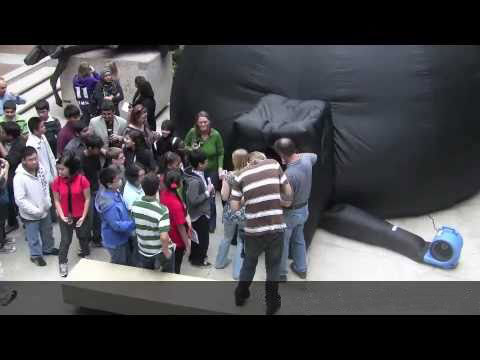 This increases the minimum possible time gap between two consecutive shows. Besides the attached door increases the weight, volume, inflation time and maintenance cost of the dome unnecessarily. Because of more weight and size such domes are cumbersome to pack or unpack.Crawl In: One as to bend on knees and crawl to enter/ exit a tunnel attached to the dome which may not be appropriate or feasible for every one like grown up girls or elderly people. These domes have higher entry/ exit transit time of the audience.
This increases the minimum possible time gap between two consecutive shows. Besides the attached door increases the weight, volume, inflation time and maintenance cost of the dome unnecessarily. Because of more weight and size such domes are cumbersome to pack or unpack.Crawl In: One as to bend on knees and crawl to enter/ exit a tunnel attached to the dome which may not be appropriate or feasible for every one like grown up girls or elderly people. These domes have higher entry/ exit transit time of the audience.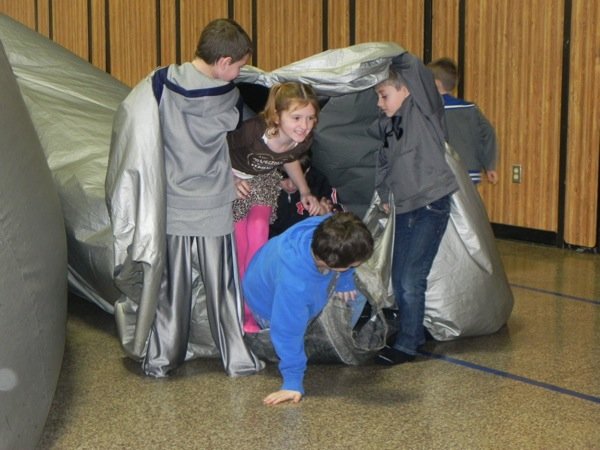 Besides the attached tunnel increases the weight, volume, inflation time and maintenance cost of the dome unnecessarily. Because of more weight and size such domes are cumbersome to pack or unpack.Walk-able: Like DigidomeTM, they have a vertical zipper embedded in the dome and the audience can simply walk in/out. Such domes are best suited for mobile planetariums as no extra tunnel or door is attached to the dome and one can simply walk in/ out through the vertical zipper. And of course such domes are cheaper.
Besides the attached tunnel increases the weight, volume, inflation time and maintenance cost of the dome unnecessarily. Because of more weight and size such domes are cumbersome to pack or unpack.Walk-able: Like DigidomeTM, they have a vertical zipper embedded in the dome and the audience can simply walk in/out. Such domes are best suited for mobile planetariums as no extra tunnel or door is attached to the dome and one can simply walk in/ out through the vertical zipper. And of course such domes are cheaper.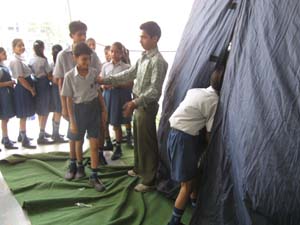 What kind of Ventilation Mechanism is there in Mobile Domes?All mobile planetarium domes need inlet for the blower/fan to inflate the dome. For fresh air circulation air outlet tunnels are attached to the dome.What is the weight of a Mobile Planetarium Dome?A typical 5 meter mobile planetarium dome can weigh from about 15 Kg to 70 Kg depending upon the nature of fabric, various fabric coatings and door mechanism. Digidome weigh is less than equals to 25 Kg. "Lighter the better"Can a mobile dome be used outdoors?No, all inflatable mobile planetarium domes are for indoor use.How to Repair/ Maintain a Mobile Dome?The adversity of the venues at times and accessibility of the dome to the curious participating children can make the dome quite vulnerable. The projection surface of the dome has to be handled with care. Besides over a period of time pinholes develop on the dome from where light peeps in. The dome also creates a rolled up skirt at its base that simply rests on the floor to the inside. This skirt is the most vulnerable part of domes as audience may walk over it or sit on it. For repairs the dome can be stitched and/ or pasted with adhesive tapes. It can be cleaned with wet cloth/ sponge and painted with suitable spray paint. Every Digidome consists of 3 separable layers of namely inner or projection layers (2 in no.) and outer layer (1 in no). A with provision to use the extra second inner layer once the first one worn’s off. For walk-able entry/ exit dome that has zipper, it will be better to have extra zippers embedded in the dome. The extra zippers are for standby in case of a zipper failure. See Mobile Planetarium DomesWhat is the installation time of a Mobile Dome?Depending upon the dome design and weight a typical 5 meter dome takes up to 20 minutes to fully inflate. Shorter the time better it is, inflation time of Digidome is up-to 10 min.Is it Safe?Yes. No inflammable material or gas is used in mobile planetarium domes.Is it hot and stuffy inside?The temperature of the place where the dome is installed and the number of audience and their age governs the temperature inside the dome. For hot/ sultry weather the dome has to be installed in an air conditioned environment for the comfort of the audience. Besides the digital system also need suitable ambient temperature and humidity to operate.Are these domes wheel chair accessible?The domes do not have any solid base- to admit a person in wheel chair simply lift the side of the dome and slide the wheel chair under.What is the seating arrangement/ capacity in a mobile planetarium?The domes do not have any solid base- to admit a person in wheel chair simply lift the side of the dome and slide the wheel chair under.The audience in a mobile planetarium (full dome) is seated on the floor/ carpet in co eccentric circles facing the centre. Few chairs if required can be put inside the dome on the circumference. The seating capacity depends upon audience age, weather and the dome size.
What kind of Ventilation Mechanism is there in Mobile Domes?All mobile planetarium domes need inlet for the blower/fan to inflate the dome. For fresh air circulation air outlet tunnels are attached to the dome.What is the weight of a Mobile Planetarium Dome?A typical 5 meter mobile planetarium dome can weigh from about 15 Kg to 70 Kg depending upon the nature of fabric, various fabric coatings and door mechanism. Digidome weigh is less than equals to 25 Kg. "Lighter the better"Can a mobile dome be used outdoors?No, all inflatable mobile planetarium domes are for indoor use.How to Repair/ Maintain a Mobile Dome?The adversity of the venues at times and accessibility of the dome to the curious participating children can make the dome quite vulnerable. The projection surface of the dome has to be handled with care. Besides over a period of time pinholes develop on the dome from where light peeps in. The dome also creates a rolled up skirt at its base that simply rests on the floor to the inside. This skirt is the most vulnerable part of domes as audience may walk over it or sit on it. For repairs the dome can be stitched and/ or pasted with adhesive tapes. It can be cleaned with wet cloth/ sponge and painted with suitable spray paint. Every Digidome consists of 3 separable layers of namely inner or projection layers (2 in no.) and outer layer (1 in no). A with provision to use the extra second inner layer once the first one worn’s off. For walk-able entry/ exit dome that has zipper, it will be better to have extra zippers embedded in the dome. The extra zippers are for standby in case of a zipper failure. See Mobile Planetarium DomesWhat is the installation time of a Mobile Dome?Depending upon the dome design and weight a typical 5 meter dome takes up to 20 minutes to fully inflate. Shorter the time better it is, inflation time of Digidome is up-to 10 min.Is it Safe?Yes. No inflammable material or gas is used in mobile planetarium domes.Is it hot and stuffy inside?The temperature of the place where the dome is installed and the number of audience and their age governs the temperature inside the dome. For hot/ sultry weather the dome has to be installed in an air conditioned environment for the comfort of the audience. Besides the digital system also need suitable ambient temperature and humidity to operate.Are these domes wheel chair accessible?The domes do not have any solid base- to admit a person in wheel chair simply lift the side of the dome and slide the wheel chair under.What is the seating arrangement/ capacity in a mobile planetarium?The domes do not have any solid base- to admit a person in wheel chair simply lift the side of the dome and slide the wheel chair under.The audience in a mobile planetarium (full dome) is seated on the floor/ carpet in co eccentric circles facing the centre. Few chairs if required can be put inside the dome on the circumference. The seating capacity depends upon audience age, weather and the dome size.Dome Diameter 5 meter/ 16 feet 6 meter/ 19 feet 7 meter / 23feet Seating Capacity 25 Adults OR 45 Young Children 40 Adults OR 75 Young Children 60 Adults OR 95 Young Children G. Fixed Planetarium Dome-
What is a Planetarium Projection Dome Screen?It is defined as the curved surface (hemisphere) preferably of grey colour where the projection is done. It should be as seamless as possible. The main challenge while designing/ constructing a planetarium projection dome screen is its acoustics (echo). It can be constructed in fibre or brick (civil work) however, in such domes acoustics (echo) will be an acute problem. Perforated aluminium panels that are fitted to a MS support structure are prevalent the world over. The aluminium projection dome screen is padded at the back with high density rock wool to solve the acoustics- echo problem. Now days Fibre domes especially up to 7meter diameter are also prevalent. These domes can also be hanged from the ceiling.

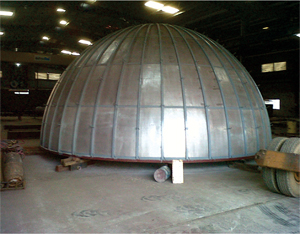
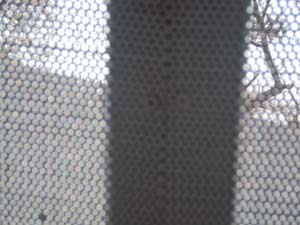 What kind of Architectural Ambience do you suggest for a Fixed Planetarium?A fixed planetarium is often perceived and promoted as a tribute to history of science, our understanding of the heavens above and achievements of human space endeavours. In a way it epitomizes science and technology from the point of view of a common man. The architectural ambience of a planetarium in a city's skyline often reflects the same in an epic form. The outside surface of a planetarium projection dome screen is always hidden as it is enclosed under a protective structure that is usually of brick and mortar called envelope/ shell. It is this envelope/ shell that is designed from aesthetics point of view to give a fixed planetarium a suitable epic ambience. The envelope need not necessarily be dome shaped. Decision makers, for the envelope's ambience, can also choose from many cost effective options that are now days available for example aluminium composite panels (ACP). The ACP construction also takes less time to construct.
What kind of Architectural Ambience do you suggest for a Fixed Planetarium?A fixed planetarium is often perceived and promoted as a tribute to history of science, our understanding of the heavens above and achievements of human space endeavours. In a way it epitomizes science and technology from the point of view of a common man. The architectural ambience of a planetarium in a city's skyline often reflects the same in an epic form. The outside surface of a planetarium projection dome screen is always hidden as it is enclosed under a protective structure that is usually of brick and mortar called envelope/ shell. It is this envelope/ shell that is designed from aesthetics point of view to give a fixed planetarium a suitable epic ambience. The envelope need not necessarily be dome shaped. Decision makers, for the envelope's ambience, can also choose from many cost effective options that are now days available for example aluminium composite panels (ACP). The ACP construction also takes less time to construct.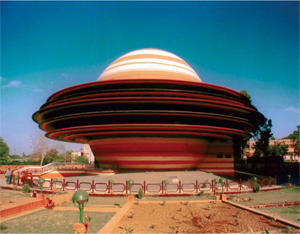
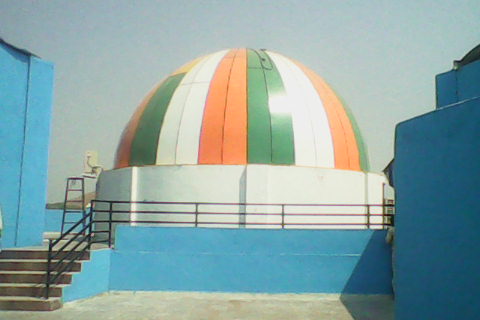
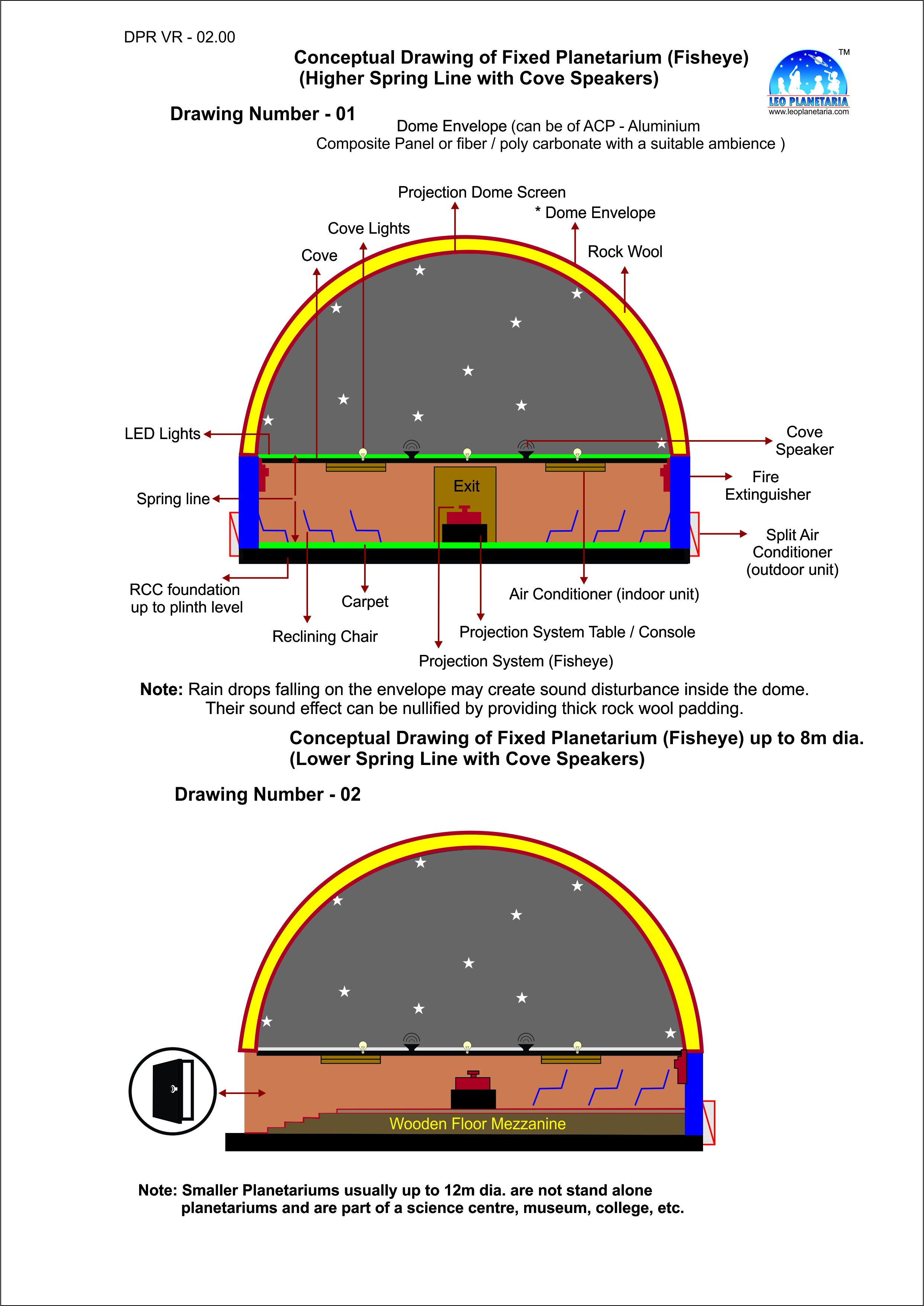
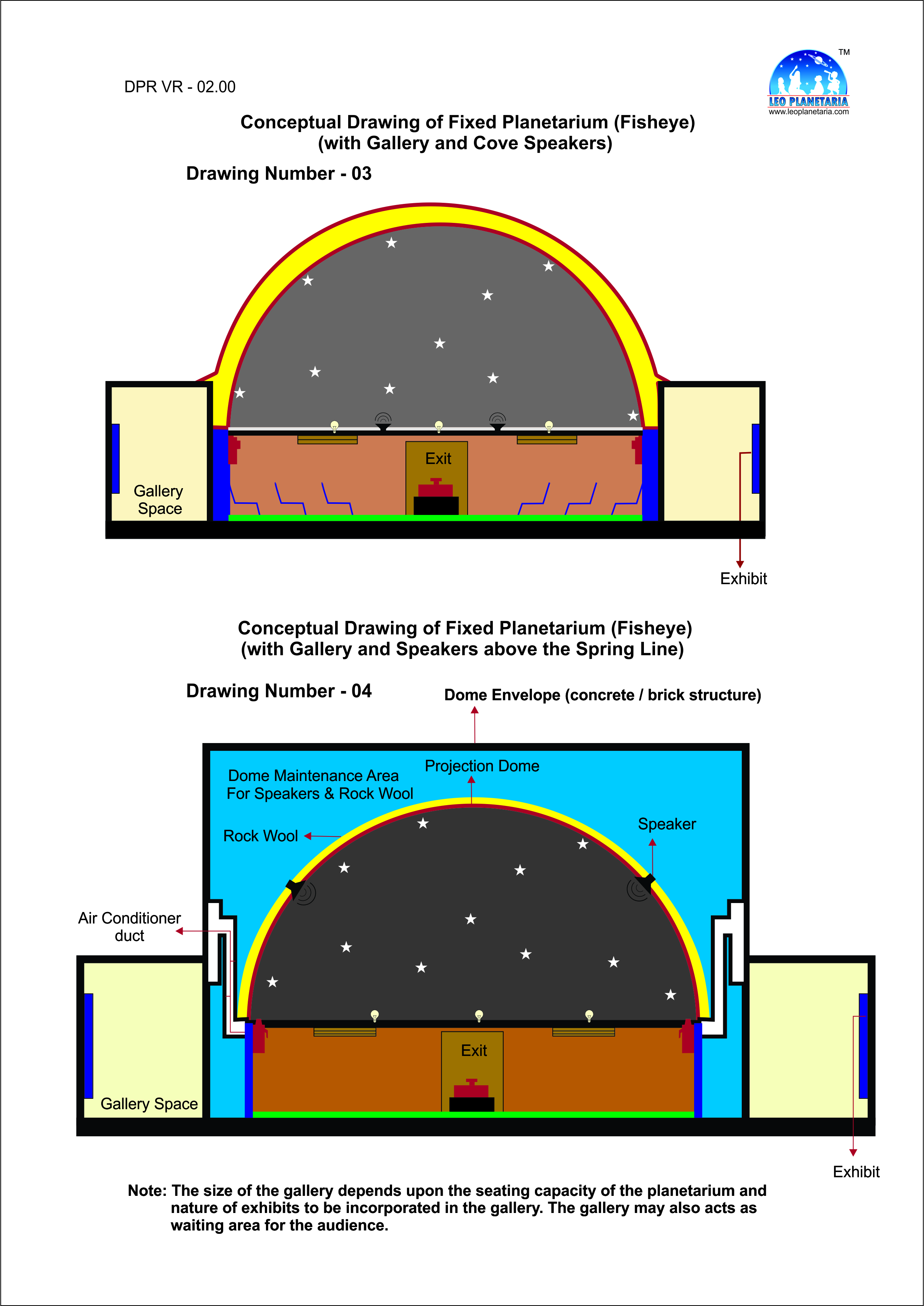 What is a Spring Line, Cove, Entry/ Exit doors and Operators Console?Spring - line :It is the height from the planetarium floor from where the projection/ horizon in a planetarium start. Remember horizon is parallel to the ground/ floor. The planetarium projection dome screen is placed on the spring line. For fixed domes of diameter 10 meters (and more) spring line is about 2 meters. For smaller domes lower spring heights (5 feet) are recommended because higher spring lines for smaller domes are counter-productive to 3d immersive planetarium environment. To create smaller spring line one can use wooden mezzanine floor. The spring line area is always given suitable acoustics treatment just like the projection dome screen to control the sound echo.Cove:Cove in a planetarium is defined as the circular band of about up to 12 inches in the spring line just below the planetarium horizon. It is used to place lights and projectors (for multiple projector system). The speakers can also be placed in the cove (which is cost effective) or can be embedded on the projection dome screen at a suitable acoustics height. The latter is a better option from acoustics point of view. However, the fisheye system with cove placement of speakers provides freedom in construction of the envelope/ shell. As now the maintenance gap/ area to be left between the envelope/ shell and the planetarium projection dome screen for the speakers is not paramount.Entry/ Exit Doors:Acoustics compatible doors are part of the spring line or one can say that they are embedded in the spring line.Operator's Console/ Booth:Operator Console/ booth is defined as the operating area for the user to primarily control computers, audio and lights. It is inside the spring line and at the circumference of the dome. For fisheye system a centre table is required to place the projector and an operator console/ booth may not be required as such.What kind of seating arrangements/ capacities are there in Fixed Planetariums?A planetarium uses fixed reclining chairs that are usually grouted to the floor. The floor is carpeted to have better acoustics. Seating arrangement/ direction is primarily governed by the fact whether the content/ shows are full dome (astronomy based) or unidirectional (non astronomy based) and accordingly is co-eccentric facing the centre of the dome or unidirectional facing one side of the dome. The former is more suitable for astronomy oriented content. The reclining angle is usually 30 to 45 degrees. For full dome more the reclining angle better it is however, higher reclining angle will have an adverse affect on the seating capacity.
What is a Spring Line, Cove, Entry/ Exit doors and Operators Console?Spring - line :It is the height from the planetarium floor from where the projection/ horizon in a planetarium start. Remember horizon is parallel to the ground/ floor. The planetarium projection dome screen is placed on the spring line. For fixed domes of diameter 10 meters (and more) spring line is about 2 meters. For smaller domes lower spring heights (5 feet) are recommended because higher spring lines for smaller domes are counter-productive to 3d immersive planetarium environment. To create smaller spring line one can use wooden mezzanine floor. The spring line area is always given suitable acoustics treatment just like the projection dome screen to control the sound echo.Cove:Cove in a planetarium is defined as the circular band of about up to 12 inches in the spring line just below the planetarium horizon. It is used to place lights and projectors (for multiple projector system). The speakers can also be placed in the cove (which is cost effective) or can be embedded on the projection dome screen at a suitable acoustics height. The latter is a better option from acoustics point of view. However, the fisheye system with cove placement of speakers provides freedom in construction of the envelope/ shell. As now the maintenance gap/ area to be left between the envelope/ shell and the planetarium projection dome screen for the speakers is not paramount.Entry/ Exit Doors:Acoustics compatible doors are part of the spring line or one can say that they are embedded in the spring line.Operator's Console/ Booth:Operator Console/ booth is defined as the operating area for the user to primarily control computers, audio and lights. It is inside the spring line and at the circumference of the dome. For fisheye system a centre table is required to place the projector and an operator console/ booth may not be required as such.What kind of seating arrangements/ capacities are there in Fixed Planetariums?A planetarium uses fixed reclining chairs that are usually grouted to the floor. The floor is carpeted to have better acoustics. Seating arrangement/ direction is primarily governed by the fact whether the content/ shows are full dome (astronomy based) or unidirectional (non astronomy based) and accordingly is co-eccentric facing the centre of the dome or unidirectional facing one side of the dome. The former is more suitable for astronomy oriented content. The reclining angle is usually 30 to 45 degrees. For full dome more the reclining angle better it is however, higher reclining angle will have an adverse affect on the seating capacity.Dome Size
(meter)Number of chairs
(approximate)7 30 8 60 10 100 12 120 15 250 For fixed domes smaller than 7 meter diameter it would be better to have the audience seated on the floor/ carpet just like in a mobile planetarium.H. Planetarium Education™ Support-
What do you mean by Planetarium Education™ Support?It is designed to empower educators/ institutions to use a planetarium as frequently as they want to cover astronomy topics from very basic to advance levels and even extend the sphere of planetarium to non astronomy topics like geography, earth science, space science, and a whole lot more. The idea is to support planetarium educators/ institutions/ science centres on effective and the fullest use of the planetarium technology so that the planetarium rather than working on novelty alone works on :
- Pragmatic, cost effective, easy, regular and widespread basis so that the conspicuous lacuna of astronomy in the education system can be filled effectively
- Sky simulation that liberates the teaching fraternity from the impediments associated with empirical astronomy.
- Customized content as per the age, ethos, acumen and syllabus of the students/ general public.
- Content that is pedagogically scale-able to a desired level.
- Content that is supported by booklets/ Maps/ Handouts/ Activities/ Quizzes/ Competitions based tests.
It consists of images, panoramas, videos clips, real time render clips, music that can be downloaded at user end and can be played on the dome as and when required. Various support material like scripts, booklets, hand outs, tests, maps, etc can also be downloaded at user end for distribution among students/ audience. It also provides support for content development in companionship to training and otherwise also and technical support for the system till the life of the system.
I. Training-
What kind of training do you provided on planetarium content development?Two types of training are provided Basic and Advance. Training
-
What kind of educational background is prerequisite for advance training provided by you?For Basic Training, minimum 12th pass is required and for advance preferably a computer literate graduate with physics as major. Training
© leoplanetaria.in





